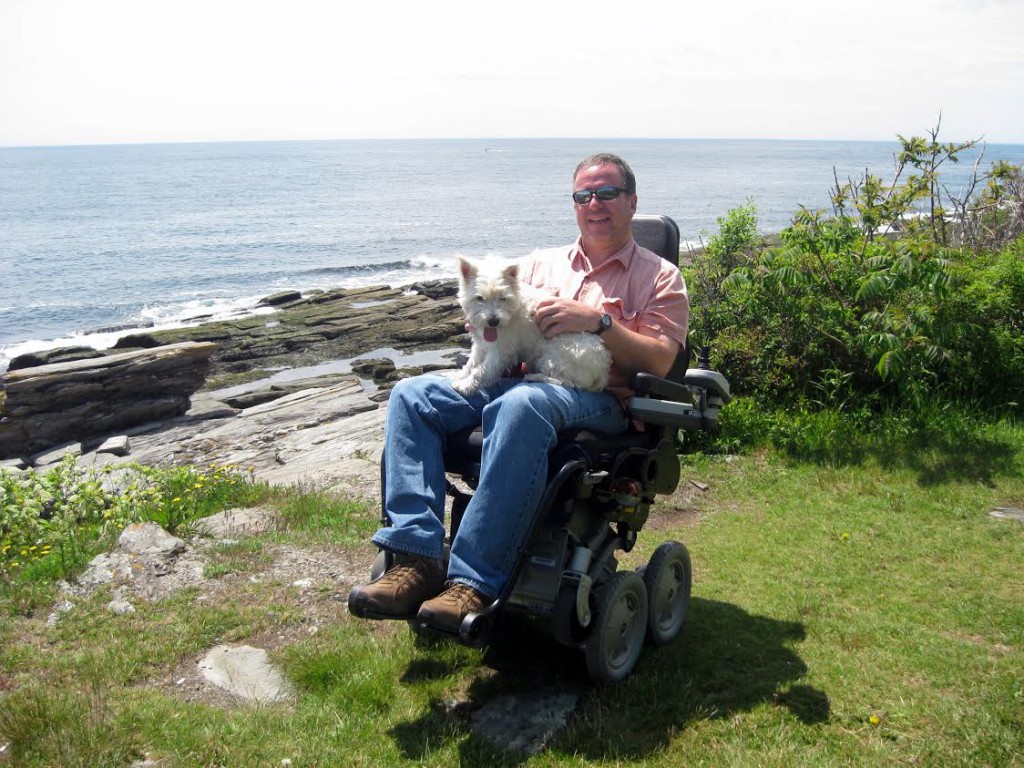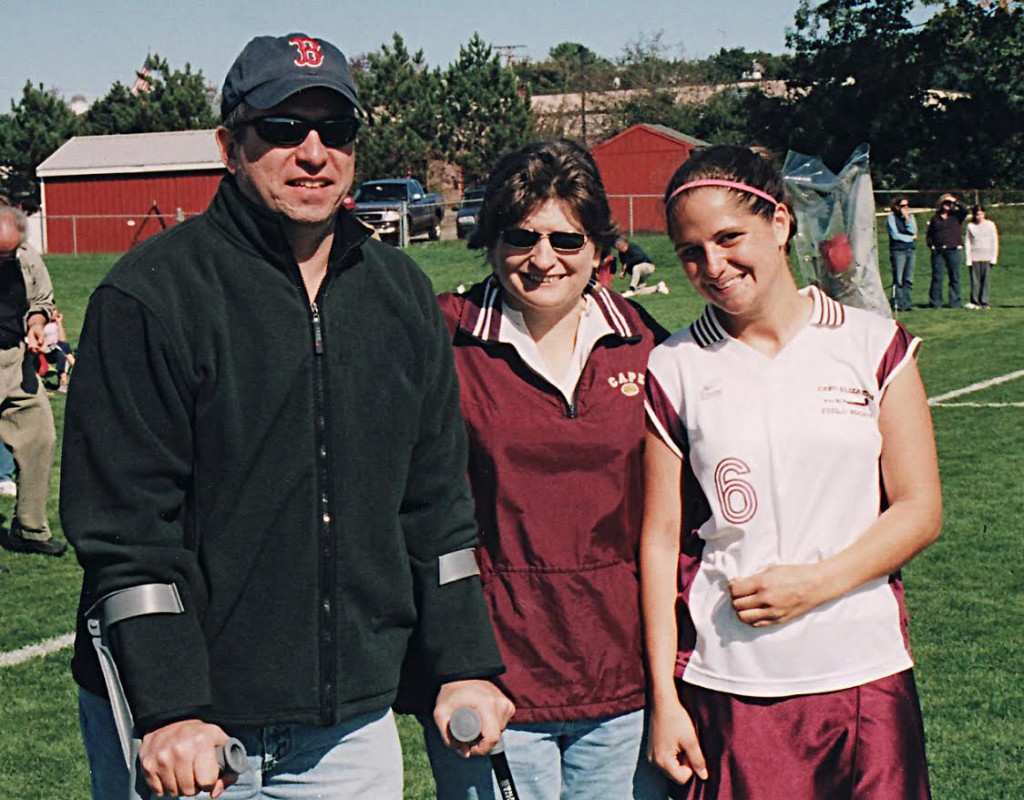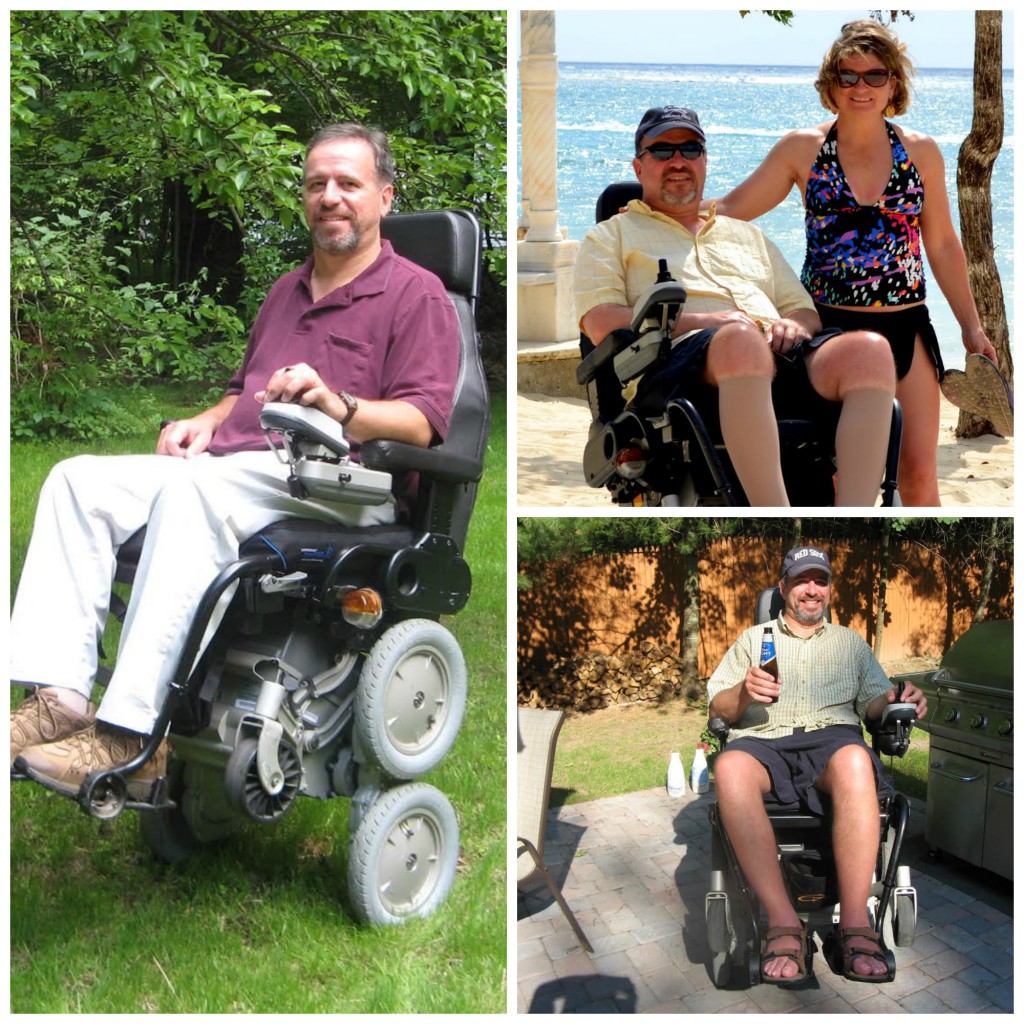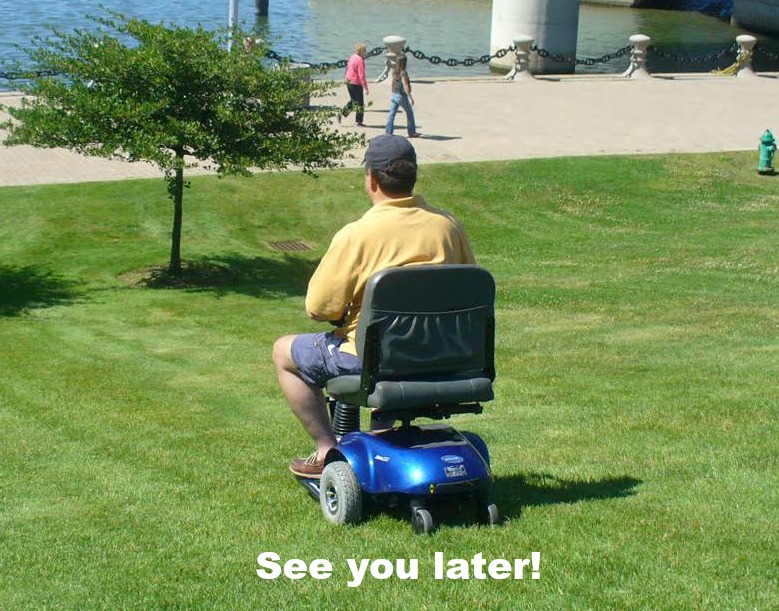Outside of this blog, Mitch has laid out his story from the moment he knew something was wrong to today on MyCounterpane.com and you can find his profile using the search tool on the site. You can also read MItch’s additional musings on enjoyingtheride.com
The Tale Of The Concerned Wife And Resistant Husband
“Do you think a cane would be helpful?” my wife asked after watching me narrowly avoid a fall, and not for the first time. I was diagnosed with primary progressive multiple sclerosis three years earlier, and I was only starting down a path that would, fourteen years later, leave me unable to walk, work, or take care of my own daily needs.
I knew the answer to Kim’s question. However, if I responded with a “yes,” she wouldn’t have let the issue rest until I bought a cane, and rightfully so. But I wasn’t ready to wear that scarlet letter in public – to let everyone I might encounter know that I was weak or feeble. My life had been about achievement – physical, academic, professional – and I wanted to remain that guy.
“No, I don’t think a cane would help me. I’m still doing fine,” I said. Was I though? Not at all, but my self-image, which I had worked so hard to cultivate, clouded the truth.
A couple of days later, as we roamed the shops in downtown Portland, I happened upon a display of hand-carved, hardwood canes. They didn’t look clinical at all. After I confirmed nobody was watching, I pulled one off the shelf and tried it out. I was shocked by how much it improved my walking. And the stick was gorgeous. I might allow myself to be seen with this cane, I thought as I paid the cashier. But still, I used it only inside the house at first.

My First Time
I love my city’s Fourth of July fireworks display. I’m not happy unless I’m so close to the action that my neck becomes sore from staring straight up and my breastbone vibrates from the explosions. Because we would have to park a considerable distance from the ideal viewing spot, I broke out the cane in public for the first time. We met up with a work associate of Kim’s, and she didn’t point and laugh at me; she didn’t break into tears of pity; she didn’t even seem to notice the cane. Over the ensuing weeks I brought out the cane more and more, and soon it became my constant companion.
This marked the genesis of my attitude regarding assistive devices: yes, I may have a disability, but I’m not ashamed of it, and look what I can still do. I didn’t adopt this approach overnight, however. The process took years.
Today, I realize that although it was unfortunate I needed a cane, the day I started using one, life got so much better.
The Cane Isn’t Enough Anymore
After another year of disease progression, I visited a physical therapist. She took one look at me walking with a cane and said, “I’ve got something better.” She brought out two forearm crutches. I had seen people using them before, but those folks were more disabled than me. Surely I didn’t need to go there yet.
I grabbed the forearm crutches and walked across the room. The difference was remarkable; I had so much more control. Later that day, I went to a health care supply store and ordered a pair. At first, I used only one of them, because I was still worried about appearances to some extent. But over time I realized the benefits outweighed my concerns, and I used two forearm crutches most of the time.
It was unfortunate that I needed these mobility devices, but the day I started using them, life got so much better.
Not the Cool Kind of Scooter
Although the crutches provided more stability, they couldn’t help me with fatigue issues. As my legs grew weaker, I avoided situations where I might have to walk very far, like sporting events, shopping malls, and leisurely strolls through the city or country. I wanted to try out a scooter – not the cool Vespa style, but the Rascal style, like on the classic Seinfeld episode. However, a scooter represented a quantum leap in how I would be perceived by others. Crutches say, “I’m hurting today, but maybe I’ll get better.” A scooter says, “I’m broken, and I always will be,” or so I thought.
An opportunity presented itself. Kim and I took our kids to Washington, DC for a long weekend, and I found a company who would rent me a scooter. I was comfortable with this trial because nobody would see me other than my immediate family. Within minutes, I fell in love with the scooter. As we made our way around DC, for the first time in years I didn’t slow down the rest of my family. In fact, the miles of walking left them worn out and complaining by the end of the day, while I continued to zip along at full speed.
When I returned home I realized all that I had been missing, and I ordered a scooter. This being my third mobility aid, I transitioned to it more smoothly than I had with either the cane or the crutches.
It was unfortunate that I needed one, but the day I started using a scooter, my life got so much better.
For a while I used the scooter only for long distances, and I continued to use the forearm crutches for short distances. As my disease progressed, I stopped using the crutches altogether. A scooter is a decent part-time solution, but if you ride one all day, then its shortcomings become obvious. The time had come for the ultimate mobility device.
No Longer Confined
Earlier in my disease progression, I agonized over the possibility that I might end up in a wheelchair. But as that day drew closer, I no longer felt that sense of dread. I had fully developed my healthy outlook on assistive devices. Experience had taught me that life would get so much better when I accepted a wheelchair, and it did.
Although the day I adopted each new mobility aid marked a milestone in my disease progression, the days prior were some of my worst, and the days immediately afterward were some of my best. When I resisted, because of fear of embarrassment or a feeling that I was admitting defeat, I missed out on life. When I accepted help, the world opened up for me.
Today I realize that I’m not confined to a wheelchair. I’m enabled by my wheelchair. In fact, you never know where you’ll find me, because I’m going, going, going all the time.
—————————————————————————————————————————————————————————–






My wheelchair is my life. Without it, I would be stuck in bed looking at the parking lot. With it, I am in that parking lot leaving going places just like everyone else. Yea wheelchairs!!!
KK
I want to thank you for making this cool blog and keep up the great job!